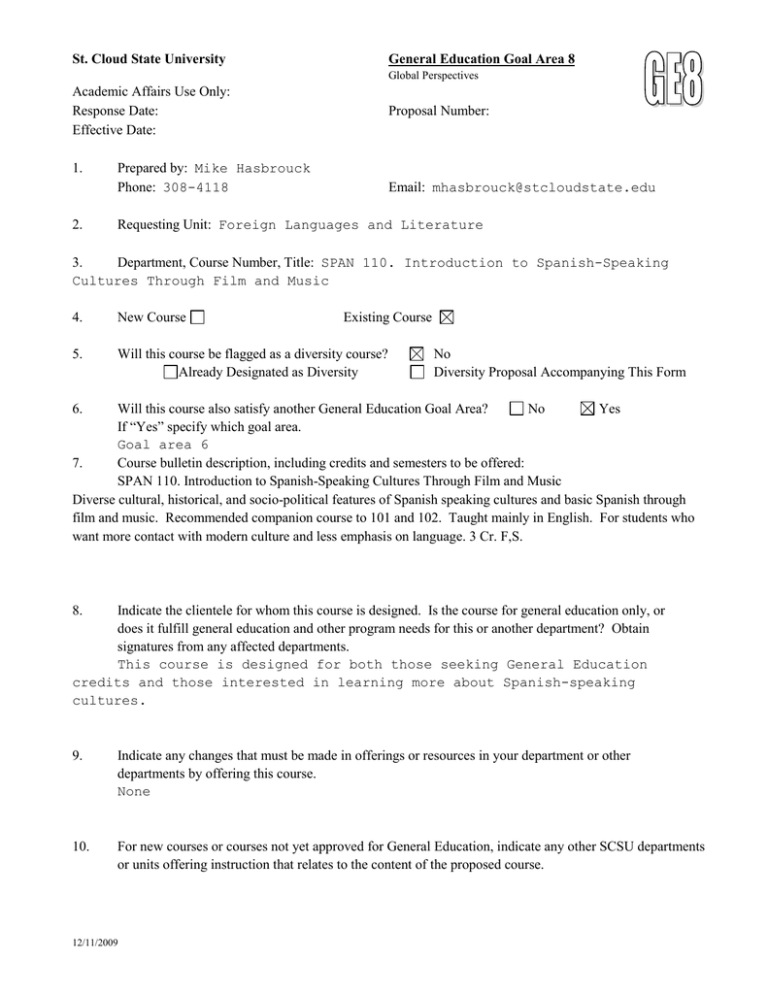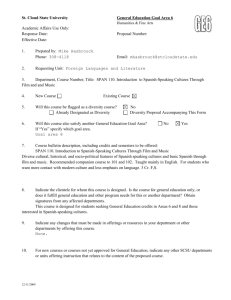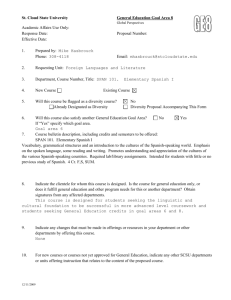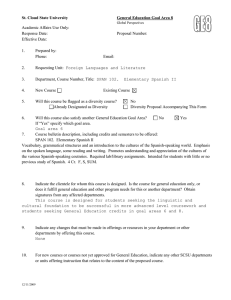St. Cloud State University General Education Goal Area 8
advertisement

St. Cloud State University General Education Goal Area 8 Global Perspectives Academic Affairs Use Only: Response Date: Effective Date: 1. 2. Proposal Number: Prepared by: Mike Hasbrouck Phone: 308-4118 Email: mhasbrouck@stcloudstate.edu Requesting Unit: Foreign Languages and Literature 3. Department, Course Number, Title: SPAN 110. Introduction to Spanish-Speaking Cultures Through Film and Music 4. New Course Existing Course 5. Will this course be flagged as a diversity course? Already Designated as Diversity No Diversity Proposal Accompanying This Form 6. Will this course also satisfy another General Education Goal Area? No Yes If “Yes” specify which goal area. Goal area 6 7. Course bulletin description, including credits and semesters to be offered: SPAN 110. Introduction to Spanish-Speaking Cultures Through Film and Music Diverse cultural, historical, and socio-political features of Spanish speaking cultures and basic Spanish through film and music. Recommended companion course to 101 and 102. Taught mainly in English. For students who want more contact with modern culture and less emphasis on language. 3 Cr. F,S. 8. Indicate the clientele for whom this course is designed. Is the course for general education only, or does it fulfill general education and other program needs for this or another department? Obtain signatures from any affected departments. This course is designed for both those seeking General Education credits and those interested in learning more about Spanish-speaking cultures. 9. Indicate any changes that must be made in offerings or resources in your department or other departments by offering this course. None 10. For new courses or courses not yet approved for General Education, indicate any other SCSU departments or units offering instruction that relates to the content of the proposed course. 12/11/2009 11. Courses designated as General Education are included in the assessment plan for the Goal Area(s) for which they are approved. Courses for which assessment is not included in the annual GE assessment report for two years will be removed from the General Education Program. The Requesting Unit understands and recognizes the above conditions. 12. Provide a concise explanation of how the following goal is a “significant focus” of the proposed course. Goal Area 8: Global Perspectives Develop a comparative perspective and understanding of one’s place in a global context. By analyzing how the distinct ethnic make-up of each region of the Spanish-speaking world influences the cultural expression of each region, students regularly compare and contrast cultures in distinct global contexts. Furthemore, the study of "other" cultures such as those of the Spanish-speaking world, involves a regular comparison of the students' native culture with the target culture/s. This leads to a broader cultural awareness and an increased understanding of the students' place in the global context. 13. In order for a course to be designated as fulfilling Goal Area 8, it must address at least 4 of the 5 student learning outcomes (SLOs) below. Check the SLOs below that are focused on in the proposed general education course. 1. Explain how they are connected and related to people elsewhere in the world. 2. Describe similarities and differences among global places and populations. 3. Analyze how political, economic or cultural elements influence relations among the world’s states, peoples, or societies. 4. Analyze specific international issues and propose and evaluate responses. 5. Articulate a vision of their individual roles and responsibilities in a common global future. 14. Discuss how each Student Learning Outcome checked above is achieved in this course. (Note: Although descriptions of typical assignments or types of assignments may be part of this discussion, it is not appropriate to submit copies of actual assignments.) 1. By its very nature, the study Spanish-speaking cultures is the study of cultural connections and relations to and between people elsewhere in the world. Students regularly analyze cultural differences and similarities that exist in distinct regions of the Spanish-speaking world, and they also compare those variations to US culture or their native culture. 2. Again, descriptions of similarities and differences among global places and populations are at the core of what the study of Spanish and Spanishspeaking cultures is all about. Students regularly identify and describe 12/11/2009 the ethnic and cultural variations that exist in the Spanish-speaking world, and they also compare those variations to English and US culture. 3. Students regularly identify and analyze how political, economic or cultural elements influence relations among countries in the Spanishspeaking world and between those countries and the US as well. 4. Students analyze how international issues such as human rights, war, illegal drug trafficking, global climate change, and globalization manifest themselves in the Spanish-speaking world. They also analyze diverse positions on those issues. 15. List or attach the Course Outline (adequately described and including percentage of time to be allocated to each topic). Curriculum Committees may request additional information. Topics larger than 20% need to be broken down further. Indicate in your course outline where the Student Learning Outcomes checked above are being met. Spain (17%) (Geography, major historical, socio-political and ethnic features =7%) (Music of Spain = 5%) (Film portraying modern life in Spain = 5%) Mexico and Central America (Mexico, Guatemala, Honduras, El Salvador, Nicaragua, Costa Rica, and Panama) (18%) (Geography, major historical, socio-political and ethnic features =8%) (Music of Mexico and CA = 5%) (Film portraying modern Mexico or CA = 5%) The Caribbean (Cuba, Dominican Republic, and Puerto Rico) (15%) (Geography, major historical, socio-political and ethnic features =5%) (Music of the Hispanic Caribbean = 5%) (Film portraying modern life in Cuba or other regional country = 5%) Northern South America (Colombia, Venezuela, Ecuador, and Peru) (15%) (Geography, major historical, socio-political and ethnic features =5%) (Music of NSA = 5%) (Film portraying modern life in country in region = 5%) Southern South America (Bolivia, Chile, Argentina, Uruguay, and Paraguay)(15%) (Geography, major historical, socio-political and ethnic features =7%) 12/11/2009 (Music of SSA = 5%) (Film portraying modern life in country in region = 5%) United States (10%) (Geography, major historical, socio-political and ethnic features = 5%) (Hispanic music or film in USA = 5%) Spanish grammar and vocabulary (10%) (basic grammar, essential vocabulary, useful expressions) 12/11/2009 St. Cloud State University General Education Transmittal Form Academic Affairs Use Only: Response Date: Effective Date: Proposal Number Department: Foreign Languages and Literature Course or Course(s): SPAN 110. Introduction to Spanish-speaking Cultures through Film and Music Mike Hasbrouck Department or Unit Chair Signature 2-15-10 Date Department forward to Academic Affairs for publication and electronically to Chair of General Education Committee, Chair of College Curriculum Committee, College Dean Recommendation of General Education Committee: Approve Remarks: Disapprove Chairperson Committee Signature Date Recommendation of University Curriculum Committee: Approve Remarks: Disapprove Chairperson Committee Signature Date Recommendation of Faculty Association: Approve Remarks: Disapprove FA Senate Signature Date Action of Academic Vice President: Approve Disapprove Signature Entered in Curriculum Data File 12/11/2009 Remarks: Date



